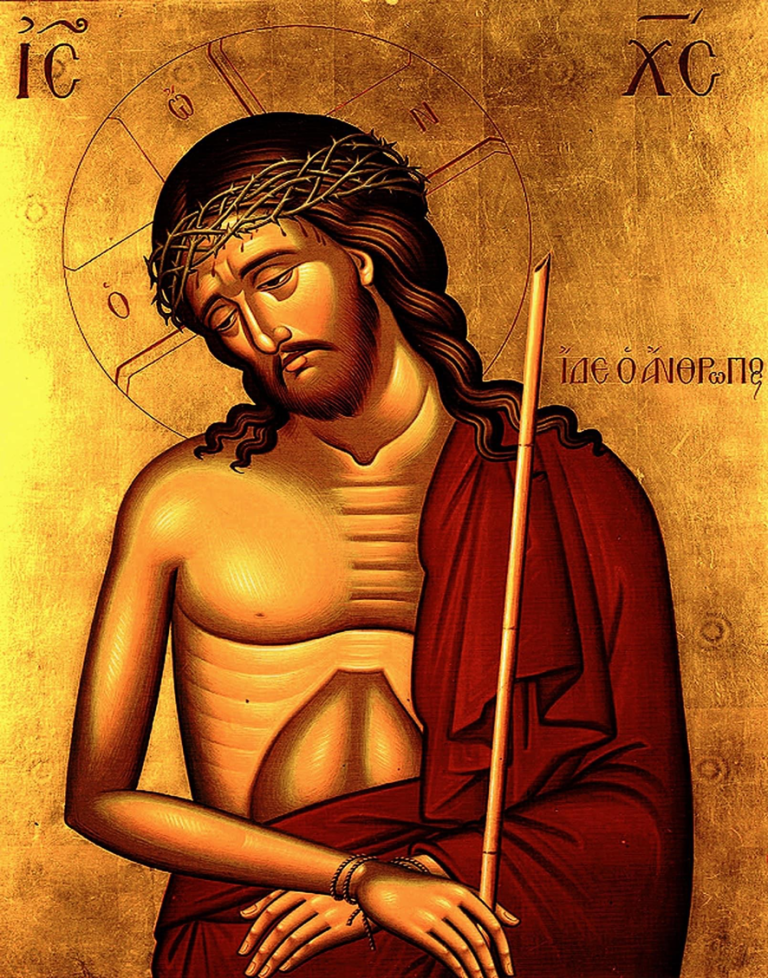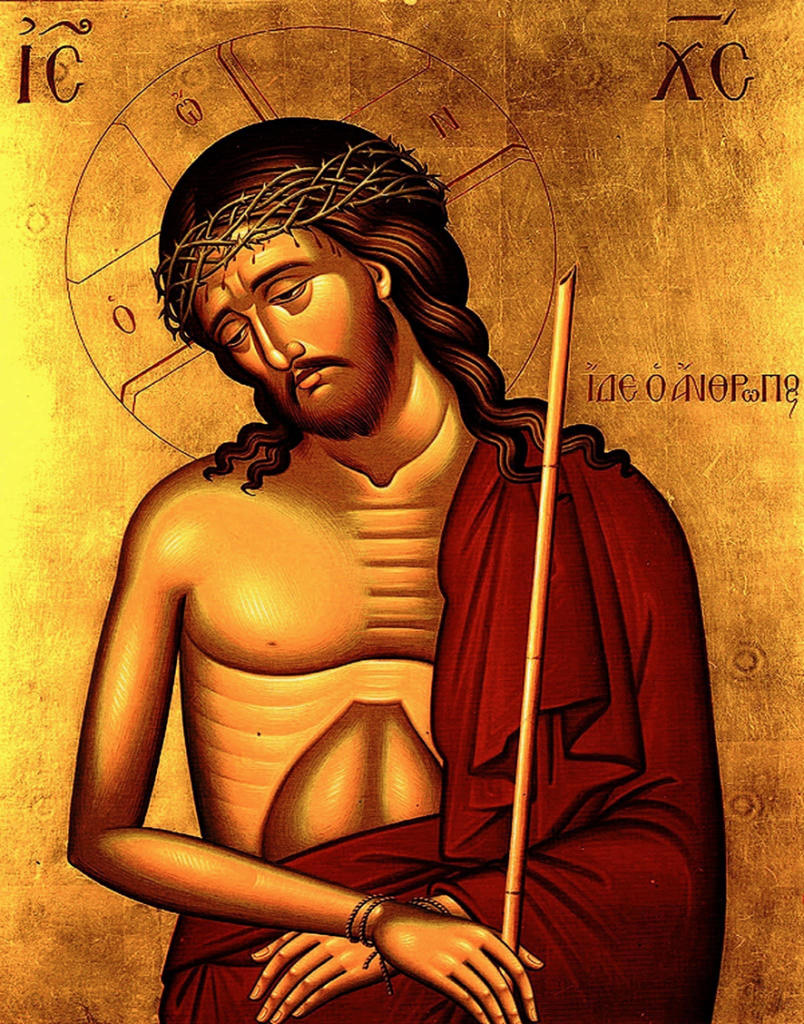

Ecce Homo – Lembrança do Milagre do Ícone Senhor Jesus Cristo em Beirute – Histórias dos Santos Padres e Documentário sobre a coroa de espinhos
A Quinta-Feira Santa – A Mística Cidade de Deus – Maria Agreda
Instrumentos da Paixão – Coroa de Espinhos
O bispo Giulio Ricci observou que as numerosas perfurações no crânio do Homem do Santo Sudário estavam distribuídas tanto anterior quanto posteriormente por toda a abóbada craniana.
Por isso estimou que a coroa de espinhos que havia sido colocada sobre este Homem não era aquela normalmente representada em forma de diadema, mas deveria ter a forma de um gorro.
Os soldados o teciam usando um capacete como forma, sem dúvida usando ramos de jujuba (ziziphus jujuba ou ziziphus spina-christi), que são flexíveis e só podem ser trançados na primavera.
Seus espinhos são muito duros e não quebram, ao contrário de outras plantas espinhosas.

Instruments of the Passover – Crown of Thorns
Bishop Giulio Ricci observed that the numerous puncture wounds in the skull of the Man of the Holy Shroud were distributed both anteriorly and posteriorly throughout the cranial vault.
For this reason he estimated that the crown of thorns that had been placed on this Man was not the one usually represented in the shape of a diadem, but must have been in the shape of a cap.
The soldiers would weave it using a helmet as a last, undoubtedly using jujube branches (ziziphus jujuba or ziziphus spina-christi), which are flexible and can be braided only during spring.
Its thorns are very hard and do not break, unlike those of other thorny plants.
Instrumentos de la Passión – Corona de espinas
Mons. Giulio Ricci observó que las numerosas heridas punzantes del cráneo del Hombre de la Sábana Santa estaban repartidas tanto en la parte anterior como en la posterior por toda la bóveda craneal.
Por esta razón estimó que la corona de espinas que se le había colocado a este Hombre no era la usualmente representada en forma de diadema, sino que hubo de tener forma de casquete.
Los soldados la tejerían tomando por horma un casco, usando sin duda ramas de azufaifo (ziziphus jujuba o ziziphus spina-christi), que son flexibles y pueden trenzarse sólo durante la primavera.
Sus espinas son muy duras y no se tronchan, a diferencia las de otras plantas espinosas.
Lembrança do Milagre de um Ícone de Nosso Senhor Jesus Cristo em Beirute – Histórias dos Santos Padres – Daniel Lerna
Na quarta sessão do Sétimo Concílio Ecumênico (ano 787) São Pedro, Bispo de Nicomédia, em evidência da necessidade da veneração de ícones, apresentou um relato de Santo Atanásio sobre um milagre ocorrido na cidade de Beirute.
Nesta cidade vivia um cristão perto da sinagoga judaica. Tendo mudado para outro lugar, deixou em casa um ícone do Senhor Jesus Cristo. O judeu, que se mudou para a casa, não prestou atenção ao ícone.
Certa vez, seu amigo notou a imagem de Jesus Cristo na parede e disse ao dono da casa: “Por que você, judeu, tem um ícone em sua casa?”
Ele então foi à sinagoga e relatou sobre esta transgressão da lei judaica.
Os judeus expulsaram da sinagoga o dono da casa, tiraram o ícone da parede e começaram a zombar dele:
“Assim como nossos pais zombaram dele, nós também zombamos dele”.
Cuspiram na face do Senhor, chicotearam o ícone, lançaram insultos, enfiaram espinhos na cabeça e colocaram uma esponja com vinagre na boca. Finalmente, pegaram uma lança e um dos judeus a cravou no lado do Salvador.
De repente, da abertura, perfurada pela lança do ícone, jorrou sangue e água.
Os rabinos judeus, vendo o milagre, decidiram:
“Os seguidores de Jesus Cristo afirmam que Ele poderia curar os enfermos. Levaremos este sangue e água para a sinagoga e ungiremos aqueles que sofrem de enfermidades, e então veremos, se isso é dito verdadeiramente Dele”.
Um vaso com sangue foi colocado na sinagoga. Ao saber do milagre, os habitantes de Beirute começaram a trazer e a conduzir à sinagoga os que sofriam de diversas doenças, e todos foram curados, tendo sido ungidos com o sangue do ícone do Salvador.
Todos os sumos sacerdotes, sacerdotes e povo judeu acreditaram em Cristo e exclamaram:
“Glória a Ti. Ó Cristo. A quem nossos pais crucificaram. A quem nós também crucificamos no ícone. Glória a Ti, ó Filho de Deus, por ter operado tal milagre! Cremos em Ti, portanto sejas Tu misericordioso conosco e nos receba!”
Os judeus foram ao bispo de Beirute e, tendo-lhe mostrado o ícone milagroso, do qual fluíam sangue e água, contaram-lhe o seu delito.
O bispo, vendo seu arrependimento sincero, aceitou-os, catequizou-os por muitos dias e depois os batizou, e depois consagrou a sinagoga e a igreja de nosso Salvador Jesus Cristo.
A pedido dos judeus, ele consagrou também outras sinagogas em igrejas, dedicadas aos santos mártires. E “houve grande alegria naquela cidade, não só porque muitas pessoas foram curadas e vivificadas, mas porque muitas almas passaram do reino dos mortos para a vida eterna”.
Remembrance of the Miracle from an Icon of Our Lord Jesus Christ in Beirut – Sayings and Stories from the Holy Fathers – Daniel Lerma
At the fourth session of the Seventh OEcumenical Council (year 787) Sainted Peter, Bishop of Nicomedia, in evidence of the necessity of icon-veneration, presented an account of Saint Athanasias and about a miracle, which occurred in the city of Beirut.
In this city lived a Christian near the Jewish synagogue. Having moved off to another place, he left behind at the house an icon of the Lord Jesus Christ. The Jew, who moved into the house, paid no attention to the icon.
One time his friend took note of the image of Jesus Christ on the wall, and said to the home-owner: “Why dost thou, a Jew, have in thy house an icon?”
He then went to the synagogue and reported about this transgression of Jewish law.
The Jews cast out from the synagogue the owner of the house, and they took the icon from the wall and began to scoff over it: “As once our fathers mocked at Him, so we also mock at Him”. They spit at the face of the Lord, lashed at the icon, hurling abuses, they thrust thorns about the head, and put a sponge with vinegar to the mouth.
Finally, they took a spear, and one of the Jews thrust with it into the side of the Saviour.
Suddenly from the opening, pierced by the spear in the icon, flowed blood and water.
The Jewish rabbis, seeing the miracle, decided:
“The followers of Jesus Christ affirm, that He could heal the sick. We shall take this blood and water into the synagogue and we shall anoint those afflicted with infirmities, and then we shall see, whether this be spoken truly of Him”.
A vessel with the blood was put in the synagogue. Having learned about the miracle, the inhabitants of Beirut began to bring and to lead into the synagogue those suffering from various illnesses, and they all were healed, having been anointed with the blood from the icon of the Saviour.
All the high-priests, priests and Jewish people believed in Chri and exclaimed:
“Glory to Thee. O Christ. Whom our fathers crucified. Whom we also crucified in the quise of Thine ico Glory to Thee, O Son of God, for having worked such a miracle! We believe in Thee, wherefore be Thou merciful to us and receive us!”
The Jews went to the bishop of Beirut and, having shown him the wonderworking icon, the blood and water having flowed from it, they told about their misdeed.
The bishop, seeing their sincere repentance, accepted them, chatechised them for many days and then baptised them, and then consecrated the synagoque the church of our Saviour Jesus Christ.
At the request of the Jews, he consecrated also other synagoques into churches, dedicated to the holy martyrs. And “there became great joy in that city, not only that many people were healed and quickened, but that many souls passed from the kingdom of the dead unto life eternal”.
Fonte do ícone: Aperges
Produzido por

Consulte a Agenda do Museu a partir de 2025 e o visite quando receber sua confirmação de visita em seu email ou whatsapp.
Por se tratar de um museu particular, é necessário se cadastrar na Comunidade MuMi e customizar sua visita.
Criação e Tecnologia: Clayton Tenório @2025 MuMi – Museu Mítico